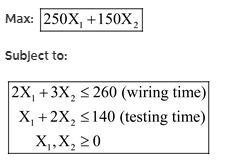Battech manufactures generators and alternators, both require wiring and testing during assembly. Each generator requires 2 hours of wiring and 1 hour of testing and are sold for a $250 profit. Each alternator requires 3 hours of wiring and 2 hours of testing and are sold for a $150 profit. There are 260 hours of wiring time and 140 hours of testing time available in the next production period and Battech wants to maximize profit. What is the optimal number of (generators, alternators) to maximize profits
Battech manufactures generators and alternators, both require wiring and testing during assembly. Each generator requires 2 hours of wiring and 1 hour of testing and are sold for a $250 profit. Each alternator requires 3 hours of wiring and 2 hours of testing and are sold for a $150 profit. There are 260 hours of wiring time and 140 hours of testing time available in the next production period and Battech wants to maximize profit. What is the optimal number of (generators, alternators) to maximize profits
Consider the info provided in the example :
Let, X1 be the number of generators and X2 be the number of alternators . The profit earned by sold of each generator is $250 and the profit earned by the sold of each alternator is $150 .
The electrotech manufactures wants to maximize the profit . Therefore the objective function for this model will be ,
Max : 250 X1 + 150 X2
The total time taken by alternator and generator is 260 hr . Therefore , time taken by each alternator and generator will be less than 260 .
2 x1 + 3 x2 ≤ 260
The total time taken by alternator and generator is 260 hr . Therefore , time taken by each alternator and generator will be less than 140 .
x1 + 2 x2 ≤ 140
Therefore, LPP model will be :

By using Simplex Method solve the LPP :
Max Z = 250 x1 + 150 x2
subject to
2 x1 + 3 x2 ≤ 260
x1 + 2 x2 ≤ 140
and x1,x2≥0;
The problem is converted to canonical form by adding slack, surplus and artificial variables as appropiate
1. As the constraint-1 is of type '≤' we should add slack variable S1
2. As the constraint-2 is of type '≤' we should add slack variable S2
After introducing slack variables
Max Z = 250 x1 + 150 x2 + 0 S1 + 0 S2
subject to
2 x1 + 3 x2 + S1 = 260
x1 + 2 x2 + S2 = 140
and x1, x2, S1, S2 ≥ 0
| Iteration-1 | Cj | 250 | 150 | 0 | 0 | ||
| B | CB | XB | x1 | x2 | S1 | S2 | Min Ratio |
| XBx1 | |||||||
| S1 | 0 | 260 | -2 | 3 | 1 | 0 | 2602=130→ |
| S2 | 0 | 140 | 1 | 2 | 0 | 1 | 1401=140 |
| Z=0 | Zj | 0 | 0 | 0 | 0 | ||
| Zj-Cj | -250↑ | -150 | 0 | 0 |
Negative minimum Zj-Cj is -250 and its column index is 1. So, the entering variable is x1.
Minimum ratio is 130 and its row index is 1. So, the leaving basis variable is S1.
∴ The pivot element is 2.
Step by step
Solved in 3 steps with 1 images






